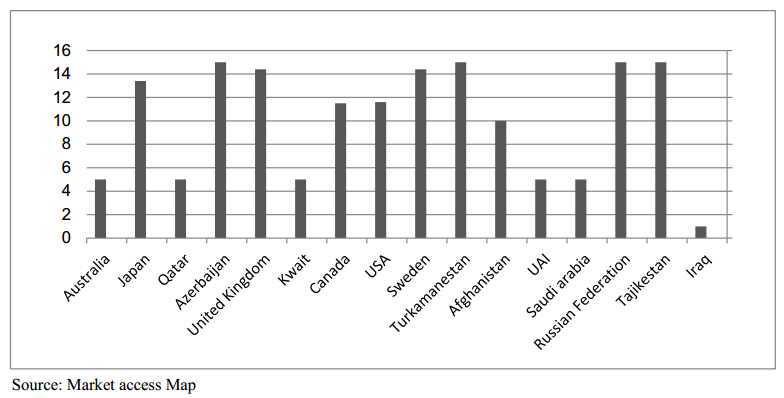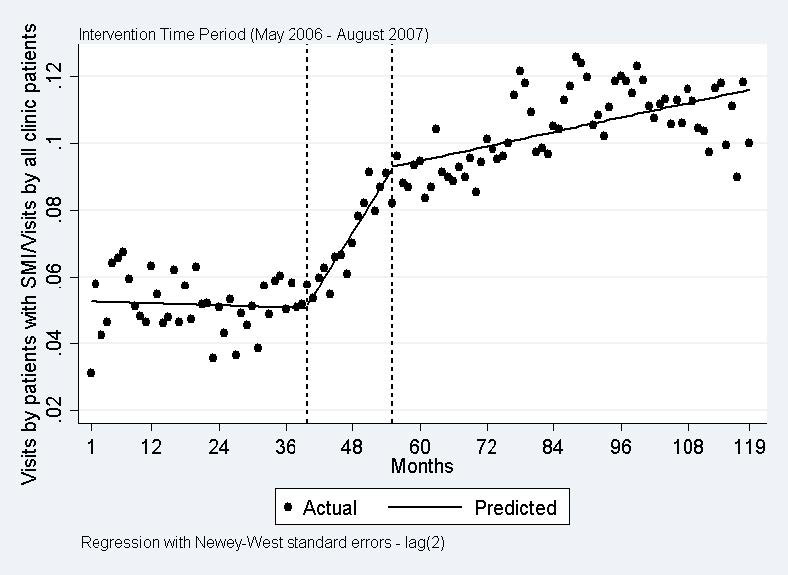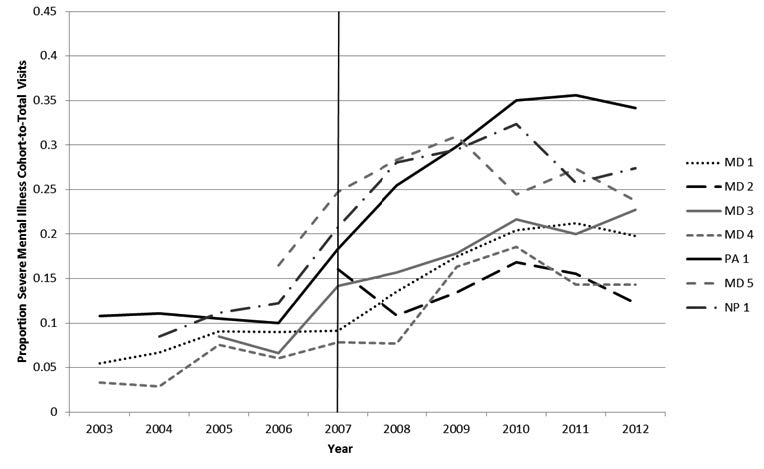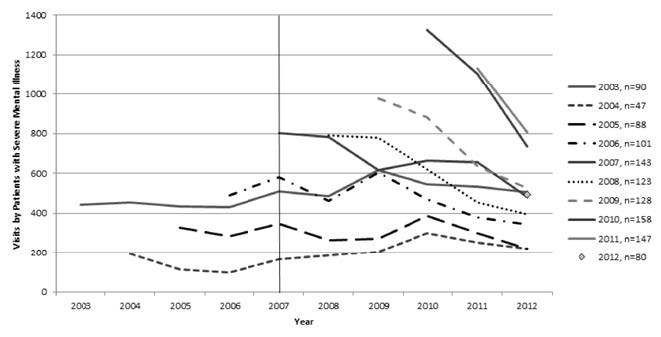1. Introduction
Competitiveness and privatization are inevitable ways to resolve problems such as unemployment and stagnation in a developing country. According to Davies and Quinlivan (2006), when business profit is divided among countries, income per capita is increased [1]. In the global market, effective ways to promote the export of products from food industry companies will provide suitable bases, especially for developing countries; meanwhile perishability and marketing of such products are inevitable and should be taken into account.
Iran is regarded as one of the countries with a background in exporting some agricultural products, especially tomato paste, to different countries through which it can create jobs and gain revenue. According to the FAO data since 2004, the Iranian tomato paste industry has generated about 60.9 million dollars worth of exports and a share of about 1.02% of the total non-oil exports [2]. During 2009–2011, the rank of Iran among major tomato paste exporter countries has improved from 10th to 7th and 6th. In 2011, the major tomato paste exporters were China, Italy, USA, Spain, Portugal, Iran, Turkey, Chili, Greece and Tunisia. The export share of Iran was approximately about 7% in Asia and 3% in the global market during the most recent 8 years (Figure 1). Additionally, Iranian tomato paste is imported by some countries, mainly Iraq, Tajikistan, Russia, Saudi Arabia, UAE, Afghanistan, Turkmenistan, Sweden, America, Canada, Kuwait, the United Kingdom, Azerbaijan, Qatar, Japan and Australia [2] and [3]. Such data indicates the improvement of the ability of Iran to compete with this product in foreign markets. Some factors and variables play major roles in export and can distinguish an effective producing sector from another. To export food-industry crops, some companies face lack of financial information, market access and sufficient marketing organization. Some studies on agricultural crops and their by-products are summarized below.
Saghaian et al. (2014), in their research on export demand estimation for the U.S. corn and soybeans to major destinations, used a log-log model and studied the advantage of using elasticity values. In this model, the export value of the product depends on variables such as the price of the corn and soybeans in America, the gross domestic product (GDP) and the exchange rate of importing countries. The results indicated that the income elasticity of China and Japan is 2.5 and 1, respectively, and corn and soybeans are substitutable crops [4].
Curzi et al. (2013) carried out research on 70 countries and several thousand food products in the period of 1995–2007. The results indicated that when there is an increase in import competition, a complex relationship is induced between improvement in quality and competitiveness [5].
In another study, Luckstead et al. (2013) indicated that although 85 percent of orange juice is produced in Florida and Sao Paulo, any reduction in US the tariff would change export values of the orange juice of Sao Paulo from Europe to the United States. Also, one of the remarkable aspects of the competition was reduction in cost of production of orange and orange juice [6].
Pierre et al. (2013) studied the effect of non-tariff barriers on foreign direct investment and the capital flow, using a gravity model. They concluded that economic growth would be achieved through productivity and trade releasing [7].
Hartman et al. (1999) studied the impact of tariff liberalization on importing juice concentrated orange and tomato paste of South America. Agglomeration and competitive models were used to aim cost comparisons of production in cases related to free trade, determine future locations for such by-products, analyze expected outcomes, and make cost comparisons and trade competitive model. Considering the increasing return to scale, greater production and export in South America, would decrease shipping cost. In case of Argentina and Brazil, it was recommended to increase their efficiency. Other results indicated that by freer trade, all countries engaging in such trade of two products, would gain more in the long run. This outcome includes both of producers and consumers, meanwhile there would not loss for U.S. producers [8].
Considering China's fast economic growth, comparative advantages have been attained in some of agricultural crops in recent decades. Chen et al. (2008) have studied the impact of food safety on China's agricultural export by applying a gravity model in which developed countries import vegetables and fish crops. Among relevant variables, the output of Chinese selected exporting crops was used instead of mass factor in the model. Such a factor incorporated the supply side effect on the exporting crop coherent to the GDP of the importing country. In addition to distance, food safety standard was also used as non-tariff barriers in the model that was more effective than tariff rate. Other factors had expected effects on the export revenue [9].
To relieve the problem of zero trade values and heteroscedasticity features in econometric models, Martinez-Zarzoso (2013) applied various methods characterized by estimators such as Pseudo Poisson Maximum Likelihood (PPML), Gamma Pseudo-Maximum-Likelihood (GPML), Nonlinear Least Squares (NLS), etc. in a gravity model. According to the results of the single estimations, using samples with real data indicated that selecting a suitable estimator was based on the nature of the data. It's noteworthy that PPML method is a case of Generalized Linear Model other than OLS (Ordinary Least Square) where in log-linear form is not effective for threshold values of dependent variable [10].
It should be noted that, contrary to other similar studies which were often based on measuring factors affecting the annual total demand of countries or sectors, the present study is aimed to identify variables that affect the revenue share of a tomato-paste company among its rivals.
In case of exporting companies, the size of the company is influential on amount of their product demand. There are up to 300,000 small and medium sized exporters in the US, which included more than 30 percent of major exports in 2012. It's noteworthy that such companies can be activated more by entering new markets. Alternative markets to export their goods depend on government enterprises while most of them did not have multiple locations to export and faced trade barriers [11]. Relating to this research, Kumar and Rai (2007) studied competitiveness of tomato and its by-products export. While India has a high rank in tomato production and cultivates more than 11 percent of the world's total tomato there, it loses a major part of the global market per annum. It is clear that by having nearly 4 percent of total production, India possesses only 0.1 percent of the total export share. In addition to criteria such as Revealed Comparative Advantages, researchers aimed to measure the effective factors of an export demand function to approach ways to promote global market share. Results indicated that in addition to competitive advantages, improving infrastructures plays a major role in the global arena. It is noteworthy that tomato by-products include value added creating income and job vacancies particularly rural societies. i.e., it will make other producing sectors engaged indirectly in a competitive cycle. Consequently, Indian policy-makers are tended to develop processed tomato in addition to itself solely [12].
According to the report of Industry, Mine and Trade Ministry of Iran in 2015, there are 58 active tomato paste processing factories. Generally, the ratio of tomato to paste is reported 6–6.5 to 1 kg in processing factories of Iran. Most of techno-food companies incorporating tomato-paste and other by-products are small and medium sized companies. One of the main reasons is that their ownership and crop characteristics are strategically excluded from state enterprises in Iran. Consideration of comparative advantages aiming to promote export value share of such companies among global rivals would not only lead to inform their economic conditions to support lasting exports to their customer bases, but also provide better planning for surplus farmed tomato as the primary crop in various geographical regions of Iran. Some annual data incorporating total tomato production and tomato paste trade, are represented in Table 1. Regarding to the data of part1 in this paper, the annual export revenue data do not direct specially comparing among rivals in the exclusive competition arena. Export incentives do not either play a major role for Iranian exporting companies1.
Table 1. Cultivated area and production of tomato and trade quantities of tomato-paste of Iran (2005–2014).
| Period |
Area |
Production |
Dry farming |
Irrigated farming |
Export |
Import |
|
1000ha |
Mt |
t/ha |
t/ha |
t |
t |
| 2005 |
147.4 |
0.5 |
15.5 |
34.4 |
28761 |
- |
| 2006 |
154.7 |
5.5 |
15.8 |
35.8 |
136898 |
0.0 |
| 2007 |
195.4 |
4.8 |
14.6 |
24.7 |
139045 |
0.0 |
| 2008 |
163.9 |
5.8 |
15.1 |
36.1 |
86821 |
0.0 |
| 2009 |
164.9 |
5.7 |
16.3 |
38.9 |
102293 |
0.3 |
| 2010 |
154.5 |
5.5 |
15.3 |
36.2 |
85778 |
0.0 |
| 2011 |
149.9 |
5.4 |
15.9 |
36.6 |
140829 |
4054.0 |
| 2012 |
150.8 |
5.6 |
16.1 |
37.6 |
111960 |
0.0 |
| 2013 |
158.2 |
6.3 |
17.7 |
39.5 |
102301 |
13.4 |
| 2014 |
151.9 |
6.0 |
19.1 |
39.6 |
128172 |
0.0 |
| *Note: Source: Based on FAO data and Customs Administration of Islamic Republic of Iran, 2015. |
1It's noticeable that according to the report of The Islamic Republic of Iran Customs Administration in 2015, by coordinating of Agriculture-Jahad and Industry, Mine and Trade Ministries of Iran, exempting export tax is related to some factors such as production surpluses, supporting producers, market status, etc. Some of agri-food crops are forbidden to export specially in drought years. However for tomato-paste this rate alternatively is determined to zero rate especially for the years of research and almost some recent years. i.e., by this way authorities aimed to plan for employment and developing production; Thereby the exporting crop will be comprised in Customs Affairs Bill and their clauses. Such enterprises do not work beneficially in a global arena and complementary factors are more impressive.
To attain practical ways to competitiveness and marketing of tomato paste and to develop the export of other food-industry products, some of the potentially important variables such as, distance, number of documents to import, productivity, common language and religion and ad-valorem tariff on the export revenue share of an Iranian tomato paste producing company, are examined in this study.
2. Materials and methods
2.1. The gravity model
According to the theoretical base of the gravity model, by Tinbergen (1962) and similar studies, the trade value, Tij, has a positive relationship with GDP and a negative relationship with distance [13]. The simple formula is:
|
$
{{\rm{T}}_{{\rm{ij}}}} = {{\rm{ \mathsf{ α} }}_{\rm{0}}}\;{\rm{Y}}_{\rm{i}}^{{\rm{ \mathsf{ α} 1}}}{\rm{Y}}_{\rm{j}}^{{\rm{ \mathsf{ α} 2}}}{\rm{D}}_{\rm{i}}^{{\rm{ \mathsf{ α} 3}}}{{\rm{ \mathsf{ η} }}_{\rm{i}}}
$
|
(1)
|
where Di comprises of all factors that prevent or cause trade; α0, α1 to α3 are parameters to be estimated and ɳi is the stochastic component. Yi and Yj are GDPs of trading companies [14].
In line with the generalized gravity model, the volume of exports between countries in year t is expressed as:
|
$
{{\rm{T}}_{{\rm{ijt}}}} = {{\rm{ \mathsf{ β} }}_0}{\rm{Y}}_{{\rm{it}}}^{{\rm{ \mathsf{ β} }}1}{\rm{Y}}_{{\rm{jt}}}^{{\rm{ \mathsf{ β} }}2}{\rm{YH}}_{{\rm{it}}}^{{\rm{ \mathsf{ β} }}3}{\rm{YH}}_{{\rm{jt}}}^{{\rm{ \mathsf{ β} }}4}{\rm{DIST}}_{{\rm{ij}}}^{{\rm{ \mathsf{ β} }}5}{\rm{F}}_{{\rm{ijt}}}^{{\rm{ \mathsf{ β} }}6}{{\rm{u}}_{{\rm{ijt}}}}
$
|
(2)
|
Where YH and DIST denote per capita income and geographical distance, respectively, and Fij refers to a specific number of variables which can be the dummy variable, like the common border, language, as well as variables that can prevent or cause bilateral trade [10].
2.2. Frequent zeros and share values
In some of economic contexts the dependent variable is obtained fractionally as 0 ≥ y > 1, e.g. the market share, the fraction of allocated land for farming, etc. [15]. In this study, the dependent variable, Sijt, has zero and share values. It is defined as the export revenue share of the ith Iranian tomato paste company of the total revenue of other tomato paste companies exporting to the jth country and it takes a fraction from zero to one.
It is noteworthy to mention that with respect to Newton's gravity, the gravity force can be very small but it cannot be zero, whereas in the trade model the trade between two countries can be zero. Nearly half of the observations related to trade contained zero values in a dependent variable. As a result, a log-linear model of the gravity equation causes some problems. One result of this is that zero data should be removed from the estimation process so that estimates can be carried out by an OLS log-linear model. Other solutions include adding 1 to the dependent variable or using a Tobit estimator. However, such procedures, too, will lead to an inconsistency that depends on the sample size and models [14].
Standard count data model used by Dennis and Shepherd [16], Berthou and Fontagné [17] and Persson [18] ignored the upper bound. The fractional data described by Ramalho and Ramalho [15], explained two methods for modeling the fractional data neglecting boundaries 0, 1; the first method considers a suitable specification of a conditional expectation for dependent fractional variable and the second assumes a limited distribution. It means that a parametric model or a conditional mean is used in the first method as a sample with the range of y Є (0, 1).
One practical approach is to use the generalized linear model (GLM)4 family. It covers different models such as linear regression, Poisson, exponential, etc. This method presumes the maximum likelihood or uses IRLS alternatively. For example, the Logit model in the binomial family has achieved results which are similar to those of the maximum likelihood through GLM [19]. In the GLM method, the normal form of the variance function is:
|
$
{\rm{V}}\left( {{\rm{y}}|{\rm{x}}} \right) = {\rm{k}}\left( {{\rm{ \mathsf{ μ} }}\left( {{\rm{x \mathsf{ β} }}} \right)} \right){\rm{ \mathsf{ λ} }}
$
|
(3)
|
where λ has limited and non-negative integer value; and it determines different sets of GLM. The corresponding λ values provide Poisson, Gamma and other statistical distributions. Moreover, the GLM method assumes that there is a function which establishes the relation between the variance and mean and allows estimation of variance with different conditions, for instance if yit has a Gaussian or Normal or other distribution, and G provides the link function, assuming:
|
$
{\rm{E}}({{\rm{Y}}_{{\rm{it}}}}) = {{\rm{X}}_{{\rm{it}}}}{\rm{ \mathsf{ β} }}
$
|
(4)
|
and it can be written as:
|
$
{\rm{g}}({\rm{E}}({{\rm{Y}}_{{\rm{it}}}})) = {{\rm{X}}_{{\rm{it}}}}{\rm{ \mathsf{ β} }}
$
|
(5)
|
It can be also logistic regression; if there is a natural logarithm function and if yit has Poisson distribution, then:
|
$
{\rm{Ln}}\{ {\rm{E}}({{\rm{y}}_{{\rm{it}}}})\} = {{\rm{x}}_{{\rm{it}}}}{\rm{ \mathsf{ β} }},{\rm{y\sim Poisson}}
$
|
(6)
|
This is a Poisson regression that is also named the linear-log model. Therefore, other function combinations are also possible [14].
In case of fractional response variable as yit and included in a panel form, let individuals as i = 1, N and time as t is 1 to T. The conditional expectation is:
|
$
{\rm{E}}({{\rm{y}}_{\rm{i}}}|{{\rm{x}}_{\rm{i}}}) = {\rm{G}}({{\rm{x}}_{\rm{i}}}{\rm{ \mathsf{ θ} }})
$
|
(7)
|
where θ is the vector of parameters and G(.) is a nonlinear function bounded between zero and one [20]. It may include logit or probit functoinal form. In a fixed effect panel data the model (8) is as:
|
$
{\rm{E}}({{\rm{y}}_{\rm{i}}}|{{\rm{ \mathsf{ α} }}_{\rm{i}}},{{\rm{x}}_{\rm{i}}}) = {\rm{G}}({{\rm{x}}_{\rm{i}}}{\rm{ \mathsf{ θ} }} + {{\rm{ \mathsf{ α} }}_{\rm{i}}})
$
|
(8)
|
αi is the time invariant unobserved heterogeneity. Because of the characteristic of G (.) with unobservable cases, consistent coefficients would not be attainable [21]. Wagner (2003) indicated that in a long panel data including cross sections and a short time period, while cross sections are infinite, fixed effect estimators would be inconsistent [22]. It's also noticeable that Var (yi|xi) is probably not homoskedastic. In this circumstance, multivariate weighted nonlinear least square and generalized estimating equation are proposed for panel data in case of serial correlation and heteroskedasticity. They are similar and use a working version of matrix Var (yi|xi)
[23].
Since the maximum likelihood and usual quasi-likelihood estimations especially in generalized linear models are not robust, estimators with better robustness are recommended. They are unbounded influenced function [24].
2.3. The model specification
Among control variables, the log of GDPs of trading countries as the monetary value are commonly used in a gravity model [25]. What is pointed by Chen et al. (2008) was that output of elected exporting crops of China was used instead of mass factor rather than GDP2. In this study considering the exporting sectors i.e., tomato paste producing companies other than the exporting country as a whole, annual value added and value added per employee of companies are considered as coherent variables instead of GDPs and GDPs per capita in such gravity-like model.
2In this regard, Evans (2001) and Hillberry (2002) offer some arguments [28,29].
Non Tariff Barriers may include unnecessary documentary requirements and all barriers other than tariffs. According to GATT article Ⅷ, minimizing trade formalities and simplifying documentations are recommended. In this matter such simplifications include documents, documentation, and inspections and etc. [26].
According to the model specification of Anderson and Van win coop (2003), estimating a gravity equation obligates to convert it to a log-linear equation [27].
In this study, according to the extended gravity model and theoretical bases, the equation of regression with all related variables in the final model is specified as follows:
|
$
{{\rm{S}}_{{\rm{ijt}}}} = {\rm{G}}\{ {{\rm{b}}_{\rm{0}}} + {{\rm{b}}_{\rm{1}}}({\rm{v}}{{\rm{a}}_{{\rm{it}}}}) + {{\rm{b}}_{\rm{2}}}{\rm{Ln}}(1 + {\rm{ta}}{{\rm{r}}_{{\rm{jt}}}}) + {{\rm{b}}_{\rm{3}}}{\rm{Ln}}({\rm{dis}}{{\rm{t}}_{{\rm{jt}}}}) + {{\rm{b}}_{\rm{5}}}({\rm{do}}{{\rm{c}}_{{\rm{jt}}}}) + {{\rm{b}}_{\rm{6}}}{\rm{Rligion}} + {{\rm{b}}_{\rm{7}}}{\rm{Language}}\} + {{\rm{u}}_{{\rm{ijt}}}}
$
|
(9)
|
Where the dependent variable Sijt is export revenue share as defined earlier.
vait is the value added per employee of a tomato paste producing unit as a common measure of productivity. There are some reasons such as different kinds of technology, capital stock, different production methods used in producing tomato paste units that have led to the selection of a homogeneous index as value added per employee among productivity indices; As mentioned above, this item is coherent with GDP per capita in the model.
tarjt is the ad-valorem tariff of the country j.
The variation between importing countries makes it possible to derive the tariff effect. This point can also be extended to non-tariff barriers.
distj is the distance between Iranian company and partner j3; docsjt is the number of documents needed for annual imports; also referring to Non Tariff Barriers.
3A part of data from CEPII is available at: Http://www.cepii.fr/anglaisgraph/bdd/distances.htm. Concerning the distance between the companies and the targeted country, it is measured by distance reported by merchants for neighboring countries. Meanwhile in some special cases such as shipping and airline, it is checked by the Google-Earth.
Religion and language are also considered as dummy variables where the common religion is Islam it took 1 otherwise zero and in case of Persian language for importing country it takes 1 and otherwise takes zero.
3. Results
In this study, descriptive and analytical methods are used by applying econometric bases. The regression estimation method is used for fractional data in the panel data in the gravity model. In this research, 12 eligible exporting-producer companies along with 16 importing countries are included. These samples involved at least 70% of importing countries and 70% of exporting companies of Iranian tomato paste to form 192 cross-sections during the years 2005–20124.
4The export process from all of the elected Iranian companies to all of the partners was not continuous during 8 years; and the data arrangement of cross-sections was logically skewed.
As shown in Table 2, Harris-Tzavalis and Hadri Lagrange multiplier stationary tests approved I (0) for all variables.
Table 2. The stationary test for the time period 2005–2012.
| Variable |
Sijt |
Ln (vait) |
Ln (1+tarjt) |
Ln (distj) |
Ln (docsjt) |
| Harris-Tzavalis test |
(time trend not included) |
| Z |
–26.74 |
–16.13 |
–27.71 |
–29.39 |
2.39 |
| P-value |
0.0000 |
0.0000 |
0.0000 |
0.0000 |
0.0000 |
| (time trend included) |
| Z |
–19.64 |
–15.50 |
–8.36 |
–5.66 |
–5.92 |
| P-value |
0.0000 |
0.0000 |
0.0000 |
0.0000 |
0.0000 |
| Hadri Lagrange multiplier stationarity test |
(time trend not included) |
| Z |
8.16 |
19.27 |
9.92 |
9.86 |
37.87 |
| P-value |
0.0003 |
0.0000 |
0.0000 |
0.0000 |
0.0000 |
| (time trend included) |
| Z |
3.04 |
3.14 |
8.91 |
9.01 |
4.09 |
| P-value |
0.0000 |
0.0000 |
0.0000 |
0.0000 |
0.0000 |
| *Note: Source: research findings. |
It should be mentioned that while there exists an 8-year period for panel data, the estimation with the GLM group is directly based on pool data and does not work for fixed and random effects.
According to the GLM family estimations, two parts including distribution and link function should be appropriately chosen; hereby, binomial and logit choice were defined to gain reasonable results shown in Tables 3 and 4, respectively. Moreover, the robust choice in standard error type contributed to resolving some of estimation problems such as heteroscedasticity and frequent values.
Table 3. Results of the generalized linear model (GLM).
| Variable |
Cons. |
Ln (vait) |
Ln (1+tarjt) |
Ln (distj) |
Ln (docsjt) |
Religion |
Language |
| Coefficient |
–23.393** |
0.493*** |
–16.090** |
–0.273** |
6.772** |
1.630*** |
1.240*** |
| Robust S.e |
6.428 |
0.088 |
4.655 |
0.903 |
2.843 |
0.320 |
0.330 |
| Prob. |
0.000 |
0.000 |
0.001 |
0.002 |
0.017 |
0.000 |
0.000 |
| Deviance = 37.57 |
Pseudo-R2 = 0.98 |
AIC = 0.0590849 |
| Pearson = 498.91 |
Log pseudolikelihood = –38 |
BIC = –11,180.6 |
| *Note: Source: Calculations of the research group. |
Table 4. Results of the Generalized Estimating Equations (GEE).
| Variable |
Cons. |
Ln (vait) |
Ln (1+ tarjt) |
Ln (distj) |
Ln (docsjt) |
Religion |
Language |
| Coefficient |
–22.920** |
0.530*** |
–14.835** |
–0.252* |
6.211 |
1.903** |
1.371* |
| Semi Robust S.e |
8.912 |
0.149 |
5.601 |
0.144 |
3.804 |
0.711 |
0.747 |
| Prob. |
0.01 |
0.000 |
0.008 |
0.080 |
0.103 |
0.007 |
0.06 |
| Pseudo-R2 = 0.98 |
Wald chi2 (6) = 64.30 |
| Scale parameter: 1 |
Prob > chi2 = 0.00 |
| *Note: Source: Calculations of the research group. |
Similar to gravity model estimations, results show significant coefficients for five factors, with a negative sign for tariff and distance, and positive sign for value added per employee for the manufacturer company (the criterion of productivity), number of documents to import and common boundary or adjacency, on the export revenue share. The coefficients of GNP per capita or (YHjt) and other related variables were not so significant to use Wald test, therefore they were dropped from results.
These results can have implications for the sample situation5. Furthermore, the two estimation methods apparently overlapped by Pseudo-R2. However, the analytical approach provides practical views.
2According to the non-linear relationship between dependent and explanatory variables and considering dummy variables, as F(x'ijβ) is an approximation, to interpret coefficient values, partial effects should be aimed at.
4. Conclusions
In this research, effective factors with a major role in competitiveness of tomato paste exporting companies were investigated through a gravity model in a panel data framework.
Since increasing and developing ways of increasing the revenue share of exporting companies were aimed at, the dependent variable approximately created a logit distribution with co-domain bounded between zero and close to one. GLMs and Generalized Estimating Equations (GEE) were used instead of other estimation methods to resolve problems such as neglecting heterogeneity, and ignoring the upper bound of the dependent variable, etc. However, based on the data structure during the estimation process, except for the robust option, GLM ignores the clustering. Thus it is recommended to justify outputs within GEE as it uses more data.
In this section, in addition to discussing the results, some suggestions are provided as follows: In both Tables 3 and 4 as a productivity index, the coefficient of value added per employee had a positive effect. It can be simply concluded that the more factories are equipped with regard to automatic and updated machines, the more productivity will be gained. This has implications for industrializing and planning an open economy with greater markets. Mutually, a more open economy through post-sanctions contracts would gradually update the level of food technology. The joining of some local factories into the form of an oligopoly can be a bailout for provincial producers.
The tariff coefficient sign implies that a one percent cut-off rate would increase the gain of exporting companies reflecting export share. It is noteworthy that importing countries with lower tariff rates mainly include Asian countries, especially the Middle East; Figure 2. It is suggested to merchant and business authorities to regulate a series of contracts and agreements with partners to cut or lower the importing tariff rates more (Development & Trade Organization, 2015). However, some business partners of the developed countries prefer their own importing rates. It may be because their local industries have aimed at the production trend via competitiveness. This is especially observable in the EU.
According to the report of the Trade and Development Organization of Iran during 2014–2015, any lowering or elimination of tariffs between Iran and partners should depend on trade negotiations and agreements through bartering goods and similar contracts. Since there are comparative advantages of some products, especially those from agri-food industries, it seems more appropriate for Iran to be a prevailed market within the Middle East countries than elsewhere. Relatedly, relieving some tariff and non-tariff obstacles obligates the membership of Iran in WTO. One result of the Uruguay Round was countries committing to cut tariffs and to bind their customs duty rates to levels which are difficult to raise. The current negotiations, under the Doha Agenda, involve continuing efforts to gain market access for agriculture and non-agricultural goods [30]. For Iran, the obstacles to international trade, such as sanctions, standard brands, etc. can be regarded as another reason. A primary item in the commercialization of a product is an open economy to achieve global standards, leading to the bargaining power that might tend to extend mutual tariff cuts. Therefore, the companies and affiliated merchandises are recommended to plan especial foreign markets which seem to have flexible customs rules or might lead to collaborate on tariff cuts in the long run. The effect of tariff liberalization through free trade between exporting and partner countries especially for tomato paste is approved in the long run. It would be beneficial for all society groups [8]. One of the unexpected results of the present study was the positive sign of documents to import, which is contrary to the theoretical bases. According to the reports of Trade Promotion Organization of Iran (2015), some informal exports and transits are being done while neglecting complete official registration. This implies that a wholesaler company may do official exports with a broad range of documents while other retailers do it with fewer registered trade details; consequently, a considerable volume of exports of tomato-paste did not undergo official arrangements and the owners of the producing companies were not necessarily engaged in the trade. Therefore, it is necessary to ensure efficient merchandising along with providing some commercial incentives for producers.
As shown in Tables 1 and 2 the distance, common language and common religion have their expected theoretical effect. This specially highlights the concentration of companies on some of neighboring countries more, despite the activities of other Asian exporting competitors e.g. Iraq, Kuwait, Tajikistan, etc. However, it is clear that any improvement in these items is subordinated to quality, brand, and marketing techniques. A certain amount of exported tomato paste is packed in aseptic and barrel packages for some advantages such as sanitation and durability [31].
Relating to this study, other approaches are recommended to be considered: Tomato paste is inevitably distributed by imperfect competition. Consequently working on brand, reputation and credibility might be as important as other qualitative privileges, companies should focus on partner companies, market glut and preferences in consumption and packing type. However, to continue increased trade with partners, facilitating trade procedure through application of the Internet is inevitably recommended since it saves time for inspections and delivery [32].
As Kumar and Rai (2007) and Hirashima (2002) [12,33] indicate, competitiveness requires some facilities such as cold chain, sanitary, phytosanitary and in relation to the productivity, improving technology in cultivation and processing i.e., tomato and paste. Thus, to attain such goals, government is obligated to improve producing and processing techniques for local and global markets.
Conflict of interest
The authors declare no conflict of interest.









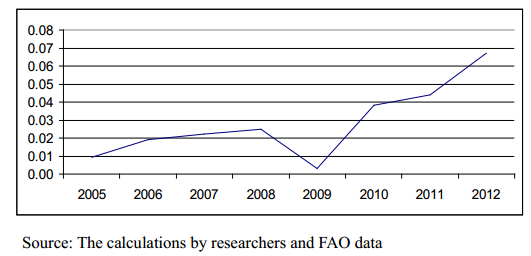
 DownLoad:
DownLoad: 